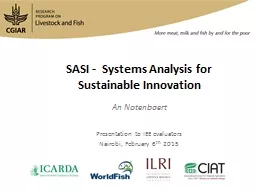

An Notenbaert Presentation to IEE evaluators Nairobi February 6 th 2015 SASIs research agenda Merger of components of several themes Targeting Sustainable Innovations TSI Value Chain Development VCD ID: 787725
Download The PPT/PDF document "SASI - Systems Analysis for Sustainable..." is the property of its rightful owner. Permission is granted to download and print the materials on this web site for personal, non-commercial use only, and to display it on your personal computer provided you do not modify the materials and that you retain all copyright notices contained in the materials. By downloading content from our website, you accept the terms of this agreement.
Slide1
SASI - Systems Analysis for Sustainable Innovation
An Notenbaert
Presentation to IEE evaluators
Nairobi, February 6
th
2015
Slide2SASI’s research agenda
Merger of components of several “themes“:
Targeting Sustainable Innovations (TSI)
Value Chain Development (VCD)
M&E and Gender
Implementation is starting in 2015 only
OBJECTIVE =
to design and guide pro-poor VC transformation and learn from the process (in an iterative way)
Slide3ASF VCs as socio-ecological systems
Consolidation
of learning from VCs with
an
aim of creating regional and global knowledge
Working at
the interface between VCTS and Technology
Flagships
Key points
Slide4VC components and actors
Production system (technologies and integrating them)VC system components (e.g. inputs, processing technologies and logistics, markets, enterprises and business development
)
Farmers, traders, processors, men, women, …
Context:
Now and in the future
e.g. sector policies and regulations, macro-economic climate & “enabling environment “, i.e. institutions and servicesIntegrationLinkages, interactions, feedbacks, …ASF Value Chains
Inputs &Services
Slide5SASI rationale
ASF VCs as socio-ecological systems:
Component research (complementing productivity flagships):
Gender
"
Value chain upgrading
Nutrition
"
Value chain transformation
Environment and NR useHolistic diagnosis and integrated intervention designInteractions with VCT and Technology Flagships: VC assessments: constraints and opportunities
research priorities in technology platforms identification of initial best-bet solutions
Multi-scale
and multi-dimensional ex-ante assessments
prioritized
integrated intervention strategies
for testing in VCT
tested
, monitored and adapted by the
VCTS team
refined
ex-ante assessments and priority
setting
M&E
Slide6SASI at the interface between
technology generation and value chain transformation
Assessment of constraints and opportunities in the VC and wider context
Guidance on formation of integrated best-bet/best-fit interventions
Guide
transformative, gender-sensitive,sustainable, pro-poor change!+ learn from the process
Slide7Objective and outcomes
To
design and guide pro-poor VC transformation and learn from the process (in an iterative way
)
System-based
approaches
for assessing the needs and appropriateness of Value Chain interventions and their uptake are being used by the other L&F flagships (technology and VCT), CRPs and development actors
;Intelligence on which integrated innovations (technological and social) to target where, to who and how is used in Value Chain Transformation and Technology flagships;Lessons and insights drawn from transformative processes are used by other CRPs, donors and development actors.
Slide8Three clusters of activities
Conduct system component research and identify promising innovations :
Gender; (b) Nutrition; (c) Natural resources and the environment; (d) VC upgrading; (e) VC transformation
Conduct systems analysis guiding the design and development of integrated intervention packages for the VCs
Diagnosis
(now and future); (b) Design
Learn lessons and adapt VC and CRP operations and activities ToC; (b) Impact assessments; (c) documentation of learning
Slide9ILRI, CIAT & WorldFish
+ WUR, KIT (x2), SEI, TI, Heifer, SNV, CIFOR, ICRAF, IFPRI, SPIA,
Makerere
, SUA, …
Slide10So far - Targeting
Targeting and priority setting:VC selectionStandardised
site selection in all VCs (with VCD)
Impact assessment
of VC
interventions:
EXTRAPOLATE, optimisation modeling, FarmDesign (with WUR)Tools and methods:“TOSA” tool database (HT/L&F)Livestock (and soon: fish) module for IMPACT modelExploration and networking for further modeling at different scalesNew livestock density maps (& geowiki)
Slide11So far - Environment
State-of-the-art lab facilities (ILRI/CCAFS/L&F/CIFOR)GHGs measurements in the fieldGHGs chambers for live animalsAdvanced measuring equipment
Impact assessments:
F
ish LCAs (Bangladesh, Egypt)
CLEANED framework
Slide12So far - Gender
Kindly hold on for Alessandra’s presentation
Slide13So far – VCD
VC assessment toolkitSituational analyses VC assessmentsEx-ante impact assessment:
SDM modeling (Tanzania)
Protocol for best-bet selection
Slide14So far – M&E
CRP Commissioned Evaluation on our Value Chain approachMEL Framework IDO Indicator Manual and projectionsImpact Pathways for all VCs
Project support (e.g. CGP,
MilkIT
,
IrishAid
in Uganda, etc.)
Slide15Some final remarksMandate and structure finally clarified
Linked into the technology flagships as well as grounded in the VC’s reality.
T
ime investment and appropriate mechanisms needed!
Slide16Slide17SASI
Systems
analysis of animal sourced food
VCs; inclusive
but not
limited to
agricultural production systemsComponent research – complementing technology researchSystems analysis and integrationLearning Analysis and assessments supporting evidence-based decision-making about integrated VC interventions
Slide18Site selection in all the value chains
A standardized approach in all countries
GIS analysis on hard criteria (poor livestock keeper)
Stakeholders’ soft criteria ranking
Groundtruthing
Rural – rural
Rural – urban
urban– urban Final site selection
Slide19A tool database : data.ilri.org/tools
Joint effort with Humidtropics Portal compiling with CGIAR open access policy
Metadata allows for flexible queries, including
gender dimension
Spatially explicitly tools
Allows for community of practice
Slide20Mazingira Lab: Measuring environmental impact of livestock and investigating mitigation options
Slide21Mazingira Lab: Measuring environmental impact of livestock and investigating mitigation options
Slide22Discovery & Delivery
Discovery is “the development of innovations that are new or applied in a different
context”
Delivery
is interpreted as “enabling innovations for (value chain) transformation and scaling.”
ITERATIVE PROCESS
* Innovations: technologies, business models, institutional arrangements, …